check engine JEEP COMPASS 2009 1.G Owner's Manual
[x] Cancel search | Manufacturer: JEEP, Model Year: 2009, Model line: COMPASS, Model: JEEP COMPASS 2009 1.GPages: 439, PDF Size: 12.51 MB
Page 361 of 439
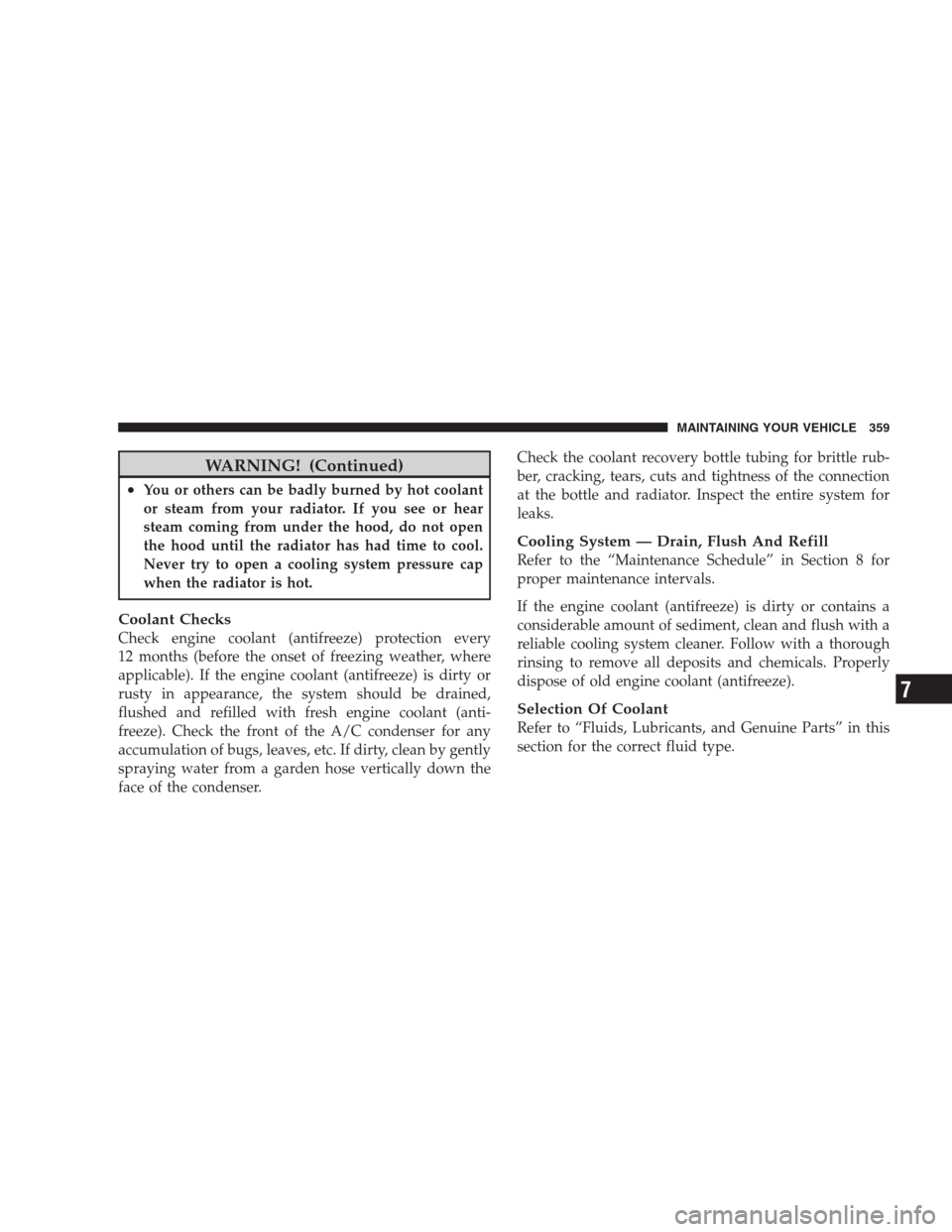
WARNING! (Continued)
•You or others can be badly burned by hot coolant
or steam from your radiator. If you see or hear
steam coming from under the hood, do not open
the hood until the radiator has had time to cool.
Never try to open a cooling system pressure cap
when the radiator is hot.
Coolant Checks
Check engine coolant (antifreeze) protection every
12 months (before the onset of freezing weather, where
applicable). If the engine coolant (antifreeze) is dirty or
rusty in appearance, the system should be drained,
flushed and refilled with fresh engine coolant (anti-
freeze). Check the front of the A/C condenser for any
accumulation of bugs, leaves, etc. If dirty, clean by gently
spraying water from a garden hose vertically down the
face of the condenser.Check the coolant recovery bottle tubing for brittle rub-
ber, cracking, tears, cuts and tightness of the connection
at the bottle and radiator. Inspect the entire system for
leaks.
Cooling System — Drain, Flush And Refill
Refer to the “Maintenance Schedule” in Section 8 for
proper maintenance intervals.
If the engine coolant (antifreeze) is dirty or contains a
considerable amount of sediment, clean and flush with a
reliable cooling system cleaner. Follow with a thorough
rinsing to remove all deposits and chemicals. Properly
dispose of old engine coolant (antifreeze).
Selection Of Coolant
Refer to “Fluids, Lubricants, and Genuine Parts” in this
section for the correct fluid type.
MAINTAINING YOUR VEHICLE 359
7
Page 364 of 439
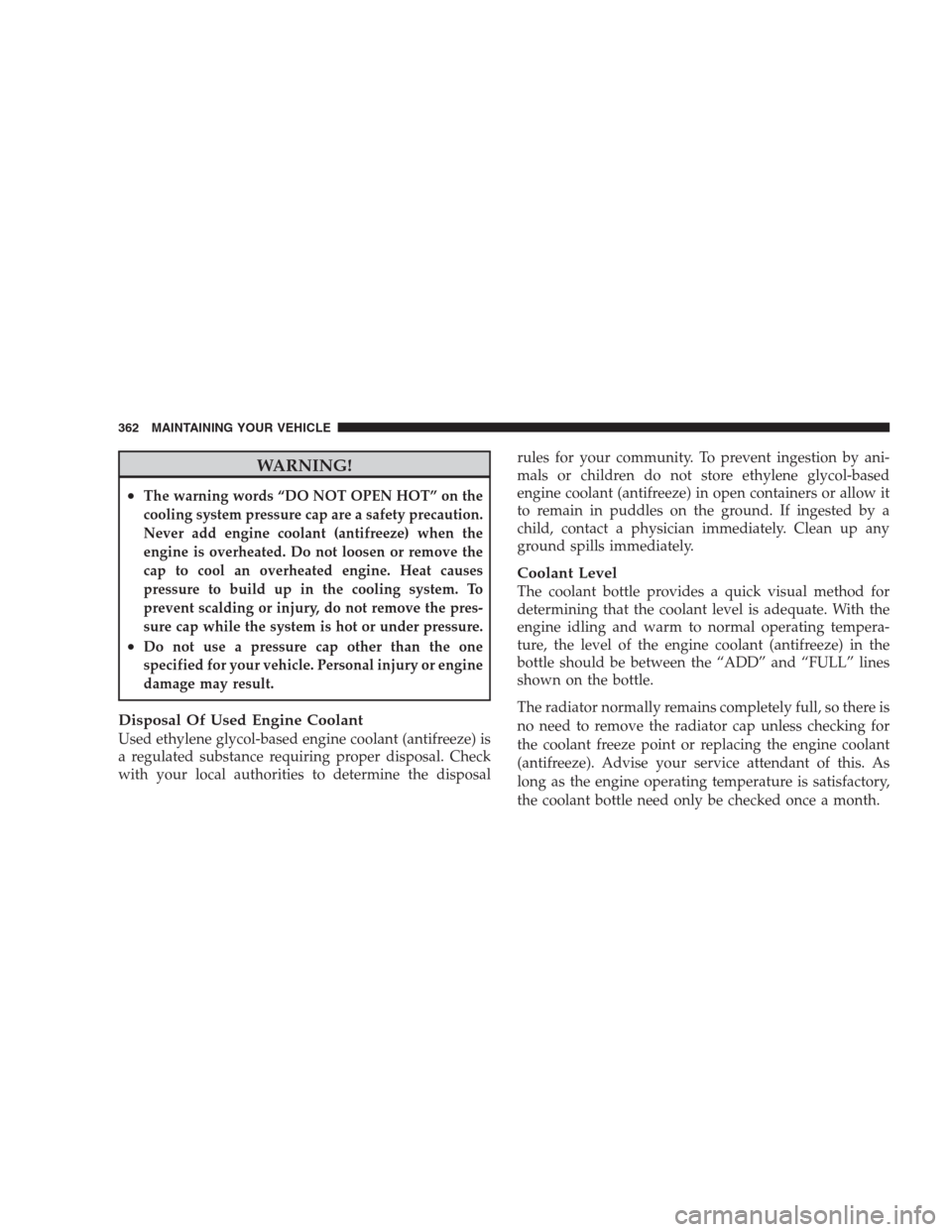
WARNING!
•The warning words “DO NOT OPEN HOT” on the
cooling system pressure cap are a safety precaution.
Never add engine coolant (antifreeze) when the
engine is overheated. Do not loosen or remove the
cap to cool an overheated engine. Heat causes
pressure to build up in the cooling system. To
prevent scalding or injury, do not remove the pres-
sure cap while the system is hot or under pressure.
•Do not use a pressure cap other than the one
specified for your vehicle. Personal injury or engine
damage may result.
Disposal Of Used Engine Coolant
Used ethylene glycol-based engine coolant (antifreeze) is
a regulated substance requiring proper disposal. Check
with your local authorities to determine the disposalrules for your community. To prevent ingestion by ani-
mals or children do not store ethylene glycol-based
engine coolant (antifreeze) in open containers or allow it
to remain in puddles on the ground. If ingested by a
child, contact a physician immediately. Clean up any
ground spills immediately.
Coolant Level
The coolant bottle provides a quick visual method for
determining that the coolant level is adequate. With the
engine idling and warm to normal operating tempera-
ture, the level of the engine coolant (antifreeze) in the
bottle should be between the “ADD” and “FULL” lines
shown on the bottle.
The radiator normally remains completely full, so there is
no need to remove the radiator cap unless checking for
the coolant freeze point or replacing the engine coolant
(antifreeze). Advise your service attendant of this. As
long as the engine operating temperature is satisfactory,
the coolant bottle need only be checked once a month.
362 MAINTAINING YOUR VEHICLE
Page 365 of 439
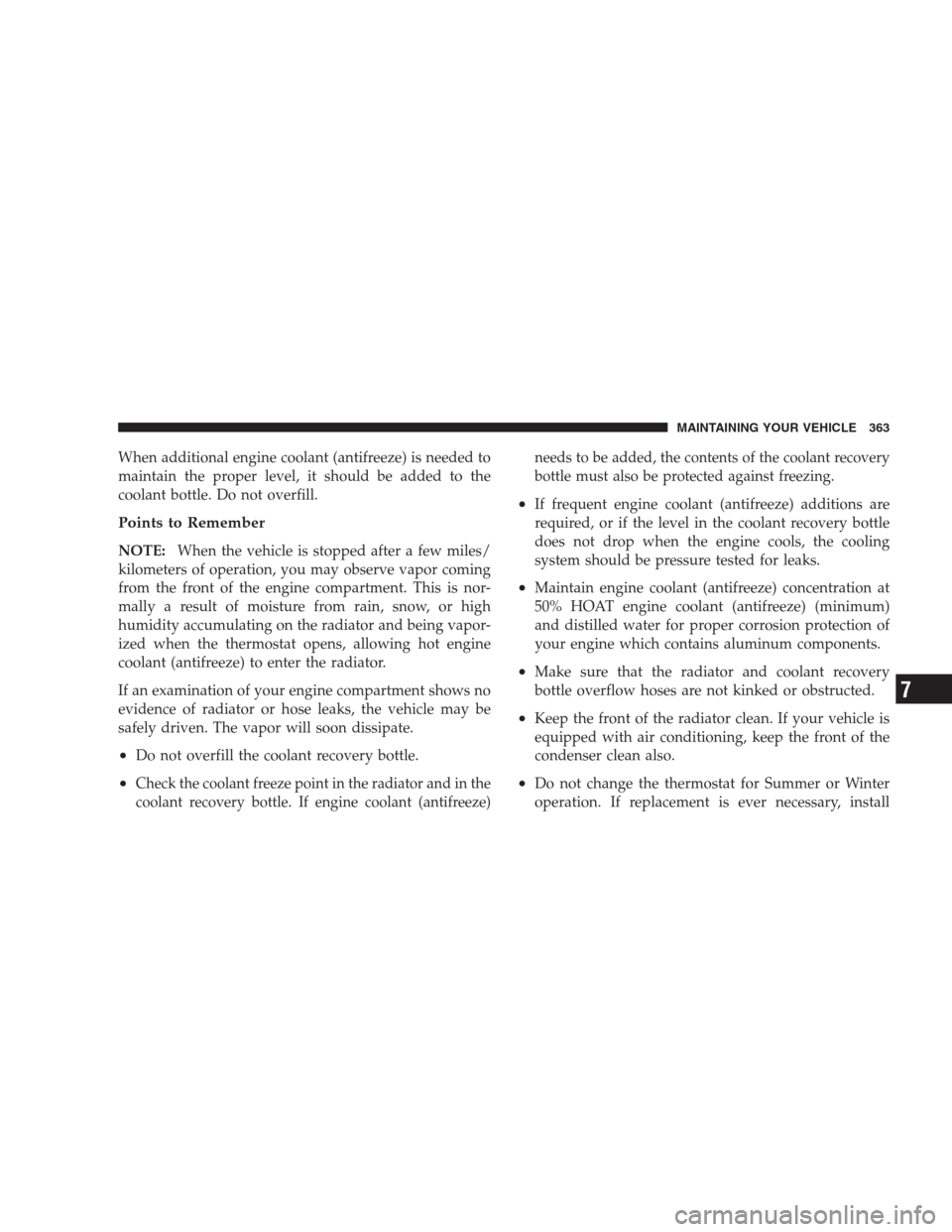
When additional engine coolant (antifreeze) is needed to
maintain the proper level, it should be added to the
coolant bottle. Do not overfill.
Points to Remember
NOTE:When the vehicle is stopped after a few miles/
kilometers of operation, you may observe vapor coming
from the front of the engine compartment. This is nor-
mally a result of moisture from rain, snow, or high
humidity accumulating on the radiator and being vapor-
ized when the thermostat opens, allowing hot engine
coolant (antifreeze) to enter the radiator.
If an examination of your engine compartment shows no
evidence of radiator or hose leaks, the vehicle may be
safely driven. The vapor will soon dissipate.
•Do not overfill the coolant recovery bottle.
•Check the coolant freeze point in the radiator and in the
coolant recovery bottle. If engine coolant (antifreeze)needs to be added, the contents of the coolant recovery
bottle must also be protected against freezing.
•If frequent engine coolant (antifreeze) additions are
required, or if the level in the coolant recovery bottle
does not drop when the engine cools, the cooling
system should be pressure tested for leaks.
•Maintain engine coolant (antifreeze) concentration at
50% HOAT engine coolant (antifreeze) (minimum)
and distilled water for proper corrosion protection of
your engine which contains aluminum components.
•Make sure that the radiator and coolant recovery
bottle overflow hoses are not kinked or obstructed.
•Keep the front of the radiator clean. If your vehicle is
equipped with air conditioning, keep the front of the
condenser clean also.
•Do not change the thermostat for Summer or Winter
operation. If replacement is ever necessary, install
MAINTAINING YOUR VEHICLE 363
7
Page 366 of 439
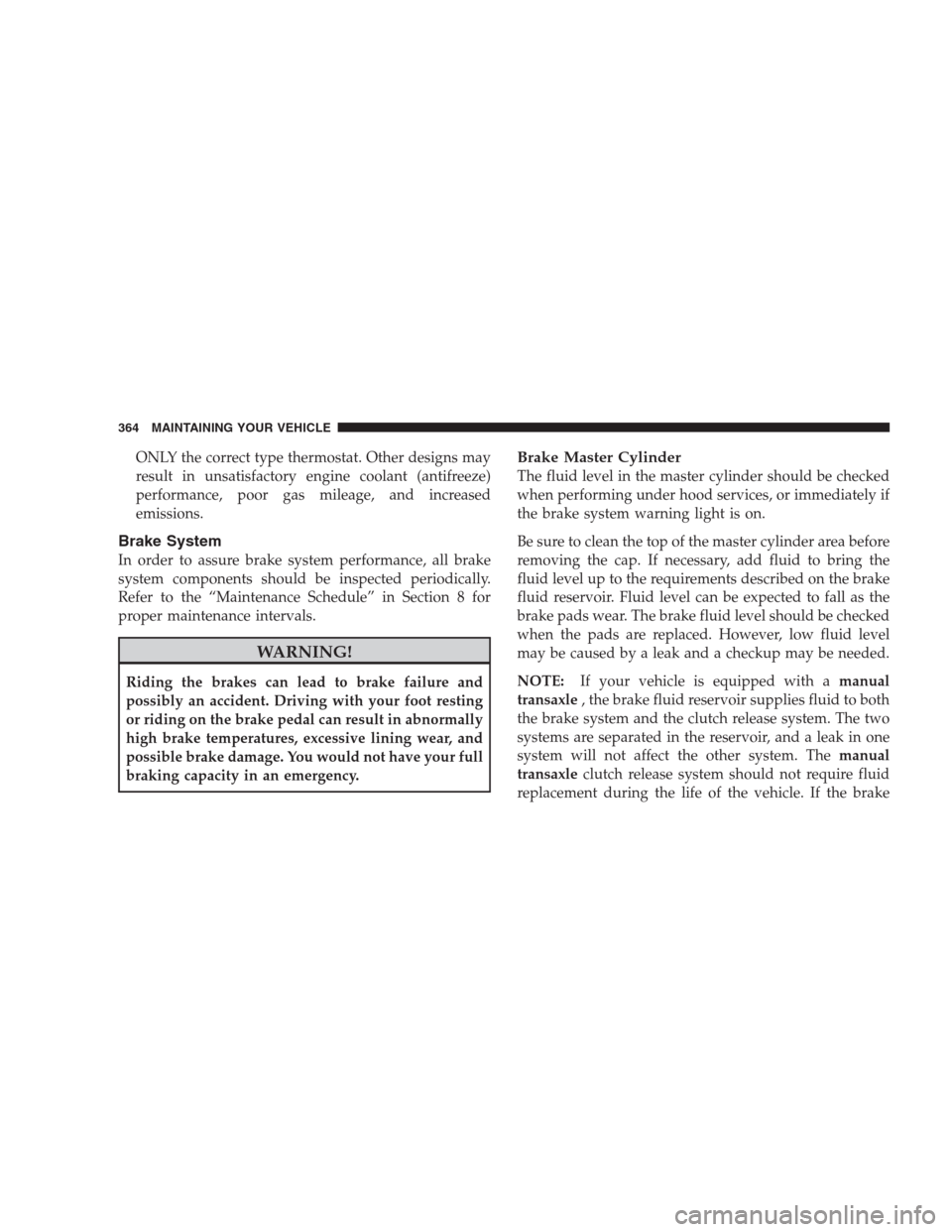
ONLY the correct type thermostat. Other designs may
result in unsatisfactory engine coolant (antifreeze)
performance, poor gas mileage, and increased
emissions.
Brake System
In order to assure brake system performance, all brake
system components should be inspected periodically.
Refer to the “Maintenance Schedule” in Section 8 for
proper maintenance intervals.
WARNING!
Riding the brakes can lead to brake failure and
possibly an accident. Driving with your foot resting
or riding on the brake pedal can result in abnormally
high brake temperatures, excessive lining wear, and
possible brake damage. You would not have your full
braking capacity in an emergency.
Brake Master Cylinder
The fluid level in the master cylinder should be checked
when performing under hood services, or immediately if
the brake system warning light is on.
Be sure to clean the top of the master cylinder area before
removing the cap. If necessary, add fluid to bring the
fluid level up to the requirements described on the brake
fluid reservoir. Fluid level can be expected to fall as the
brake pads wear. The brake fluid level should be checked
when the pads are replaced. However, low fluid level
may be caused by a leak and a checkup may be needed.
NOTE:If your vehicle is equipped with amanual
transaxle, the brake fluid reservoir supplies fluid to both
the brake system and the clutch release system. The two
systems are separated in the reservoir, and a leak in one
system will not affect the other system. Themanual
transaxleclutch release system should not require fluid
replacement during the life of the vehicle. If the brake
364 MAINTAINING YOUR VEHICLE
Page 368 of 439
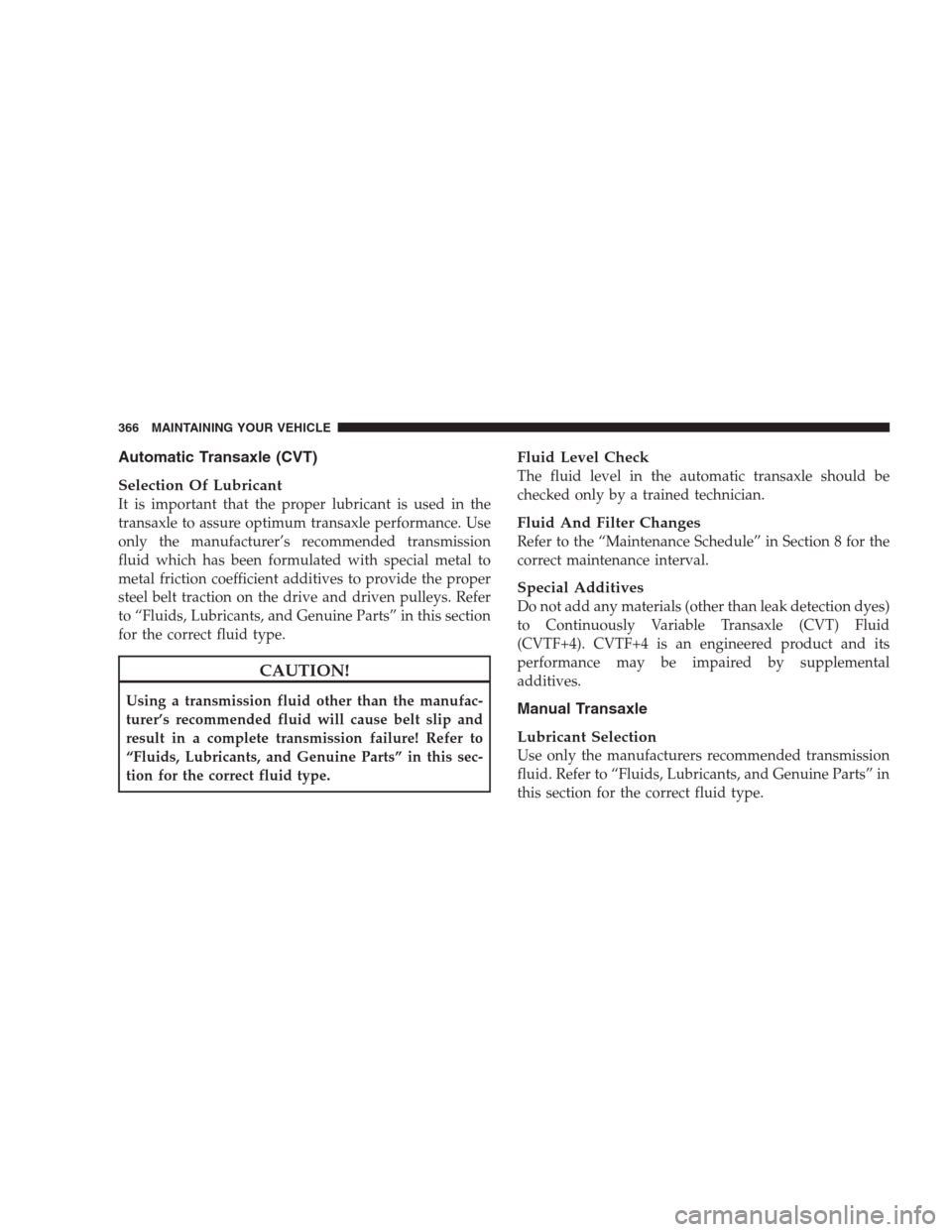
Automatic Transaxle (CVT)
Selection Of Lubricant
It is important that the proper lubricant is used in the
transaxle to assure optimum transaxle performance. Use
only the manufacturer’s recommended transmission
fluid which has been formulated with special metal to
metal friction coefficient additives to provide the proper
steel belt traction on the drive and driven pulleys. Refer
to “Fluids, Lubricants, and Genuine Parts” in this section
for the correct fluid type.
CAUTION!
Using a transmission fluid other than the manufac-
turer’s recommended fluid will cause belt slip and
result in a complete transmission failure! Refer to
“Fluids, Lubricants, and Genuine Parts” in this sec-
tion for the correct fluid type.
Fluid Level Check
The fluid level in the automatic transaxle should be
checked only by a trained technician.
Fluid And Filter Changes
Refer to the “Maintenance Schedule” in Section 8 for the
correct maintenance interval.
Special Additives
Do not add any materials (other than leak detection dyes)
to Continuously Variable Transaxle (CVT) Fluid
(CVTF+4). CVTF+4 is an engineered product and its
performance may be impaired by supplemental
additives.
Manual Transaxle
Lubricant Selection
Use only the manufacturers recommended transmission
fluid. Refer to “Fluids, Lubricants, and Genuine Parts” in
this section for the correct fluid type.
366 MAINTAINING YOUR VEHICLE
Page 393 of 439
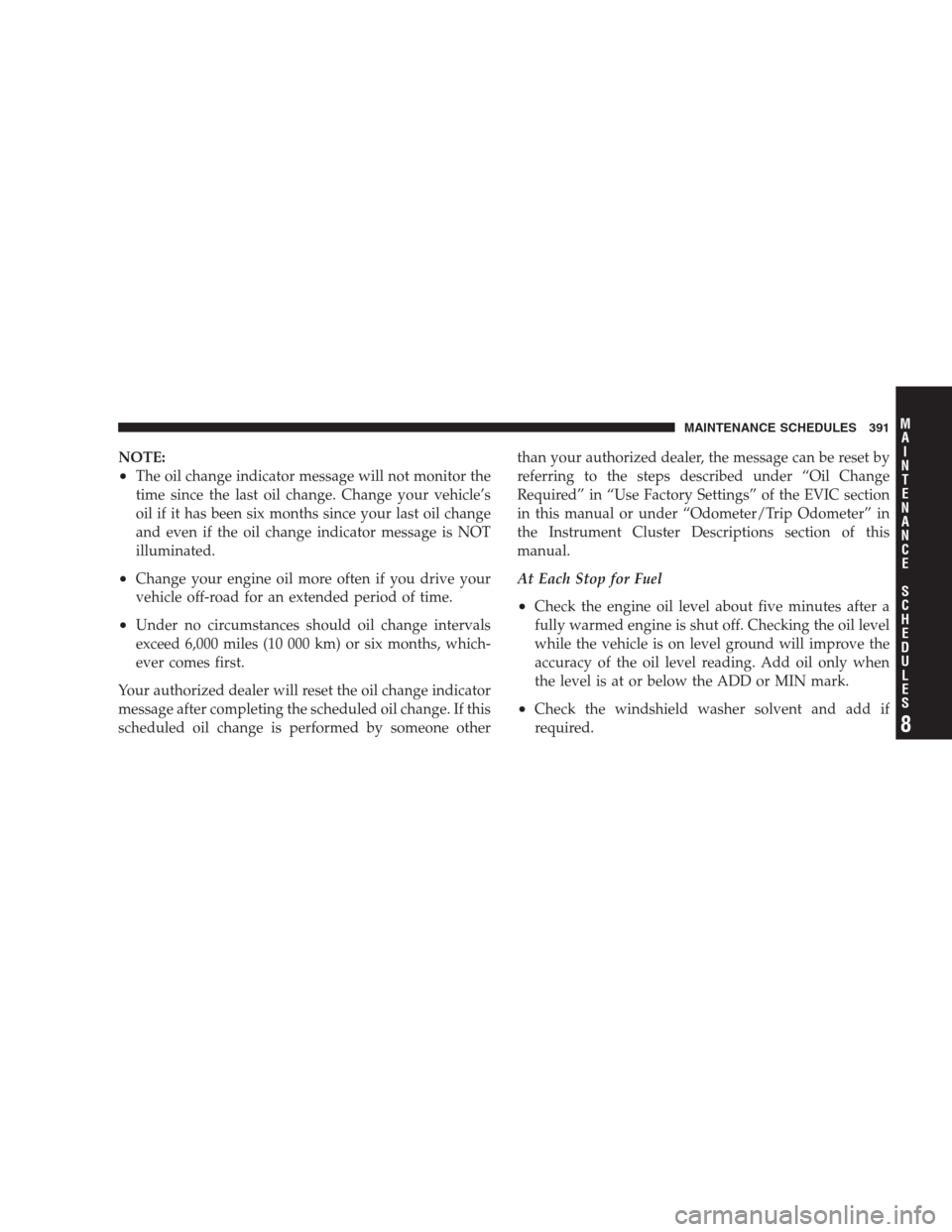
NOTE:
•The oil change indicator message will not monitor the
time since the last oil change. Change your vehicle’s
oil if it has been six months since your last oil change
and even if the oil change indicator message is NOT
illuminated.
•Change your engine oil more often if you drive your
vehicle off-road for an extended period of time.
•Under no circumstances should oil change intervals
exceed 6,000 miles (10 000 km) or six months, which-
ever comes first.
Your authorized dealer will reset the oil change indicator
message after completing the scheduled oil change. If this
scheduled oil change is performed by someone otherthan your authorized dealer, the message can be reset by
referring to the steps described under “Oil Change
Required” in “Use Factory Settings” of the EVIC section
in this manual or under “Odometer/Trip Odometer” in
the Instrument Cluster Descriptions section of this
manual.
At Each Stop for Fuel
•Check the engine oil level about five minutes after a
fully warmed engine is shut off. Checking the oil level
while the vehicle is on level ground will improve the
accuracy of the oil level reading. Add oil only when
the level is at or below the ADD or MIN mark.
•Check the windshield washer solvent and add if
required.
MAINTENANCE SCHEDULES 391
8
M
A
I
N
T
E
N
A
N
C
E
S
C
H
E
D
U
L
E
S
Page 394 of 439
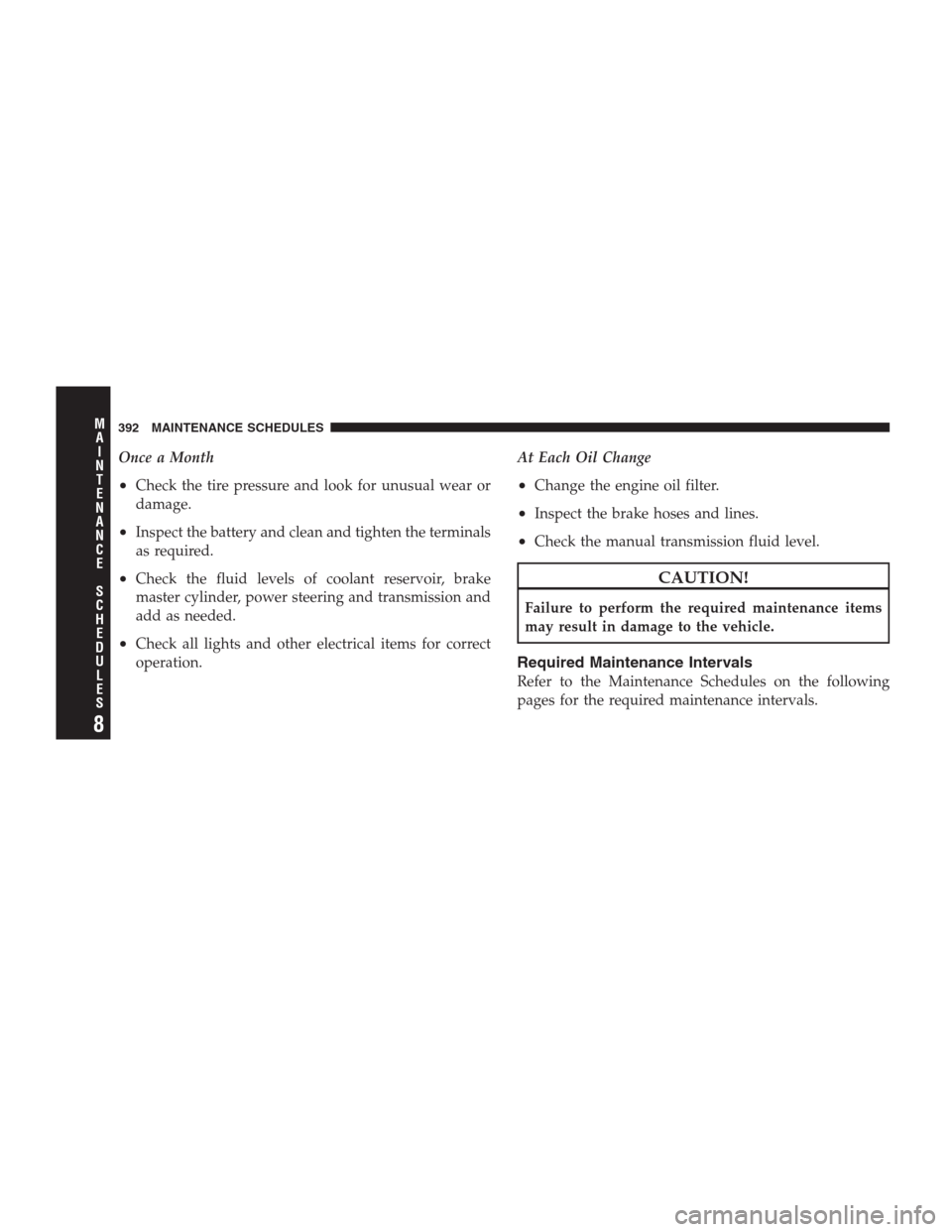
Once a Month
•Check the tire pressure and look for unusual wear or
damage.
•Inspect the battery and clean and tighten the terminals
as required.
•Check the fluid levels of coolant reservoir, brake
master cylinder, power steering and transmission and
add as needed.
•Check all lights and other electrical items for correct
operation.At Each Oil Change
•Change the engine oil filter.
•Inspect the brake hoses and lines.
•Check the manual transmission fluid level.
CAUTION!
Failure to perform the required maintenance items
may result in damage to the vehicle.
Required Maintenance Intervals
Refer to the Maintenance Schedules on the following
pages for the required maintenance intervals.
392 MAINTENANCE SCHEDULES
8
M
A
I
N
T
E
N
A
N
C
E
S
C
H
E
D
U
L
E
S
Page 420 of 439
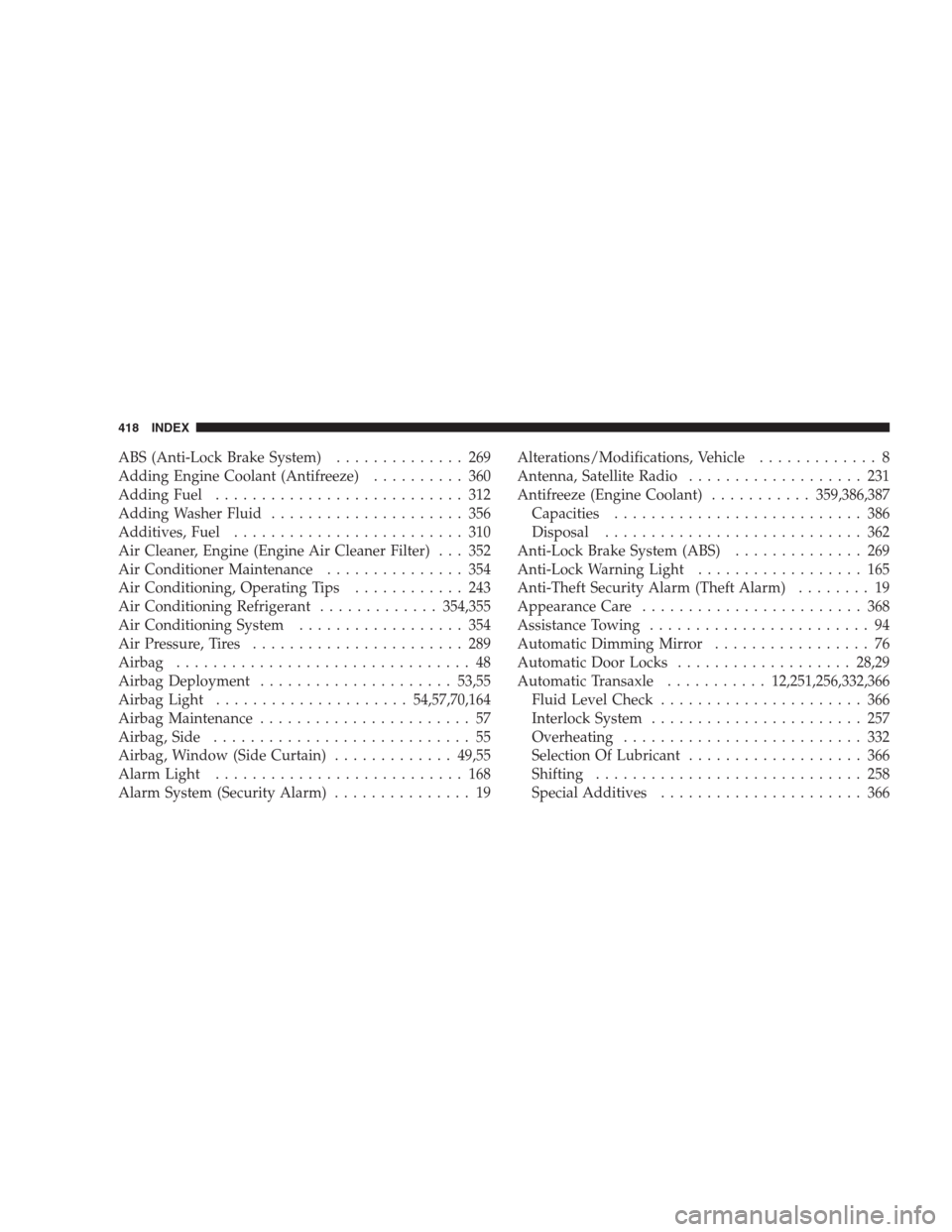
ABS (Anti-Lock Brake System).............. 269
Adding Engine Coolant (Antifreeze).......... 360
Adding Fuel........................... 312
Adding Washer Fluid..................... 356
Additives, Fuel......................... 310
Air Cleaner, Engine (Engine Air Cleaner Filter) . . . 352
Air Conditioner Maintenance............... 354
Air Conditioning, Operating Tips............ 243
Air Conditioning Refrigerant.............354,355
Air Conditioning System.................. 354
Air Pressure, Tires....................... 289
Airbag................................ 48
Airbag Deployment.....................53,55
Airbag Light.....................54,57,70,164
Airbag Maintenance....................... 57
Airbag, Side............................ 55
Airbag, Window (Side Curtain).............49,55
Alarm Light........................... 168
Alarm System (Security Alarm)............... 19Alterations/Modifications, Vehicle............. 8
Antenna, Satellite Radio................... 231
Antifreeze (Engine Coolant)...........359,386,387
Capacities........................... 386
Disposal............................ 362
Anti-Lock Brake System (ABS).............. 269
Anti-Lock Warning Light.................. 165
Anti-Theft Security Alarm (Theft Alarm)........ 19
Appearance Care........................ 368
Assistance Towing........................ 94
Automatic Dimming Mirror................. 76
Automatic Door Locks...................28,29
Automatic Transaxle...........12,251,256,332,366
Fluid Level Check...................... 366
Interlock System....................... 257
Overheating.......................... 332
Selection Of Lubricant................... 366
Shifting............................. 258
Special Additives...................... 366
418 INDEX
Page 422 of 439
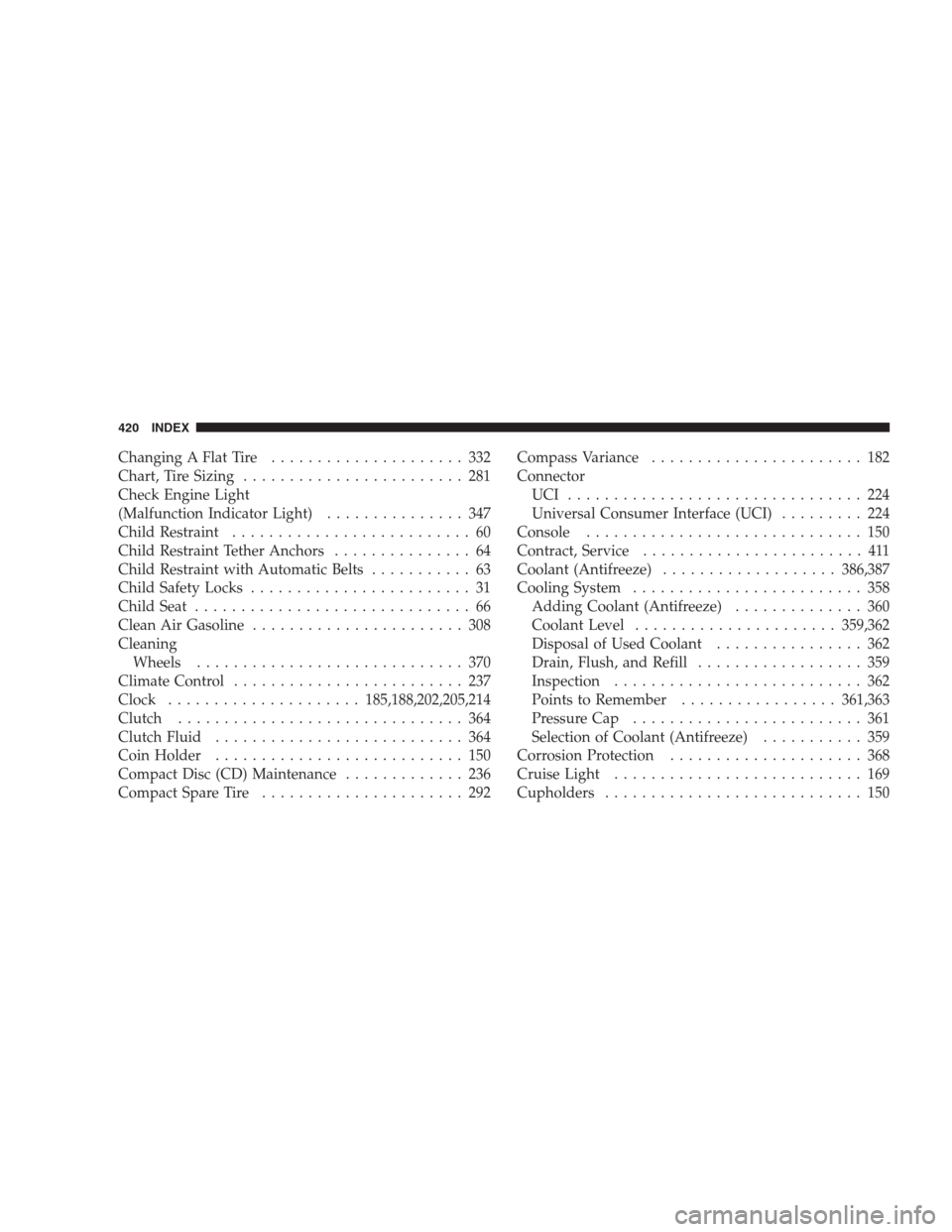
Changing A Flat Tire..................... 332
Chart, Tire Sizing........................ 281
Check Engine Light
(Malfunction Indicator Light)............... 347
Child Restraint.......................... 60
Child Restraint Tether Anchors............... 64
Child Restraint with Automatic Belts........... 63
Child Safety Locks........................ 31
Child Seat.............................. 66
Clean Air Gasoline....................... 308
Cleaning
Wheels............................. 370
Climate Control......................... 237
Clock.....................185,188,202,205,214
Clutch............................... 364
Clutch Fluid........................... 364
Coin Holder........................... 150
Compact Disc (CD) Maintenance............. 236
Compact Spare Tire...................... 292Compass Variance....................... 182
Connector
UCI ................................ 224
Universal Consumer Interface (UCI)......... 224
Console.............................. 150
Contract, Service........................ 411
Coolant (Antifreeze)...................386,387
Cooling System......................... 358
Adding Coolant (Antifreeze).............. 360
Coolant Level......................359,362
Disposal of Used Coolant................ 362
Drain, Flush, and Refill.................. 359
Inspection........................... 362
Points to Remember.................361,363
Pressure Cap......................... 361
Selection of Coolant (Antifreeze)........... 359
Corrosion Protection..................... 368
Cruise Light........................... 169
Cupholders............................ 150
420 INDEX
Page 424 of 439
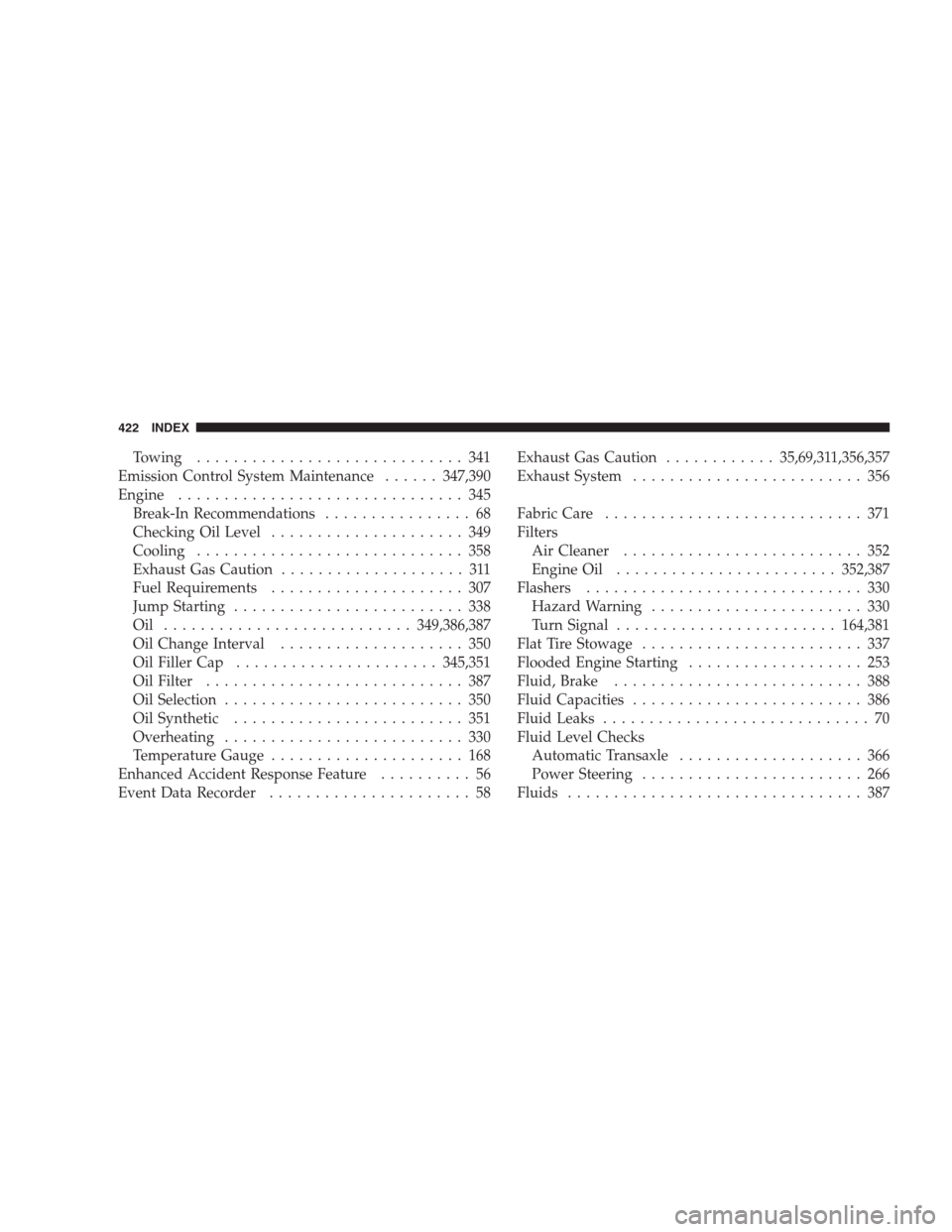
Towing............................. 341
Emission Control System Maintenance......347,390
Engine............................... 345
Break-In Recommendations................ 68
Checking Oil Level..................... 349
Cooling............................. 358
Exhaust Gas Caution.................... 311
Fuel Requirements..................... 307
Jump Starting......................... 338
Oil ...........................349,386,387
Oil Change Interval.................... 350
Oil Filler Cap......................345,351
Oil Filter............................ 387
Oil Selection.......................... 350
Oil Synthetic......................... 351
Overheating.......................... 330
Temperature Gauge..................... 168
Enhanced Accident Response Feature.......... 56
Event Data Recorder...................... 58Exhaust Gas Caution............35,69,311,356,357
Exhaust System......................... 356
Fabric Care............................ 371
Filters
Air Cleaner.......................... 352
Engine Oil........................352,387
Flashers.............................. 330
Hazard Warning....................... 330
Turn Signal........................164,381
Flat Tire Stowage........................ 337
Flooded Engine Starting................... 253
Fluid, Brake........................... 388
Fluid Capacities......................... 386
Fluid Leaks............................. 70
Fluid Level Checks
Automatic Transaxle.................... 366
Power Steering........................ 266
Fluids................................ 387
422 INDEX